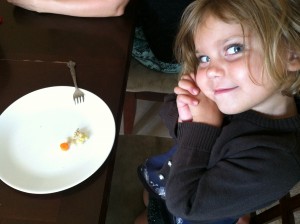 Some kids are picky eaters. Unless it’s Mac ‘n’ Cheese, a dinner role, or plain cheese pizza, these kids can cry, whine, throw fits, or just simply refuse to eat the food on their plates. After a long day at work or taking care of children, the last thing a parent wants to do is to force their child to eat food that is good for them; not to mention the irritation a parent feels when a child refuses to eat the food that the parent spent time and energy to prepare.
Some kids are picky eaters. Unless it’s Mac ‘n’ Cheese, a dinner role, or plain cheese pizza, these kids can cry, whine, throw fits, or just simply refuse to eat the food on their plates. After a long day at work or taking care of children, the last thing a parent wants to do is to force their child to eat food that is good for them; not to mention the irritation a parent feels when a child refuses to eat the food that the parent spent time and energy to prepare.
So how can a parent get their kids to eat without forceful or bribing them? When it comes to food issues a parent should consider a few things first. Is the child refusing to eat because of a hyper sensitivity to the food or is it just because the child doesn’t like (or thinks he won’t like) the food?
Some kids have sensory issues where certain textures, tastes, smells, or colors in foods are overwhelming to them and their bodies react in fear to the food. These types of physical reactions are more common in children with autism but not very common in most children. However, it is something a parent should be aware of and look out for if their children have strong negative reactions to certain foods.
Another thing to consider is a parent’s own values and beliefs around food. Since food is life sustaining, most people have some sort of emotional connection with food. Many people whose parents grew up in the depression would teach their kids to not waste anything and to finish everything on their plates. In other cultures and families, parents will encourage kids not to overeat but just eat enough to be comfortable. Being aware of one’s own values and beliefs about food may help a parent be less ridged about what and how much their kids eat. The more ridged parents are about things like food, the more likely those parents will enter into power struggles that they will likely eventually lose.
So rather than enter into a power struggle with a kid about what or how much they are going to eat, some parents set limits around food by using enforceable statements. They may respond to their kids by saying things like: “This is what we are having for dinner; eat as much as you need to in order to last until breakfast.” “Kids that are willing to eat what I choose to make at dinner get to offer suggestions about what they would like on a different night of the week.”
Some parents just model to their kids how to enjoy good food by talking it over with their spouse in front of their kids. “Honey this steamed broccoli is wonderful,” or “I love the seasoning on this chicken.” Modeling can be a very powerful tool in getting kids to do things that are healthy.
The most effective technique to get kids to eat
As a parent educator, the most effective technique that I have found to get kids to eat is the small portion technique.
When a parent prepares a plate for their child, rather than putting hearty sizes of food on the child’s plate, the parent just puts a very tiny amount of food on the plate instead. So this might look like one pea, one dab of mashed potatoes, one sliver of chicken, and one fraction of a lettuce leaf.

Basically the meal should fit on the size of a quarter. Then the parent says, “When you have finished your meal sweetheart, you are welcome to get seconds of anything we have prepared for dinner.” Since the portions are so small, it usually is not overwhelming for a child to eat their meal and over time kids get used to eating their dinner.

The less we force our children to eat their dinner, and model taking good care of ourselves by eating our dinner, the more likely our children will learn to regulate their own eating and the less likely we will enter into power struggles with our kids over food.
.
 Shiloh Lundahl, LCSW, is a child and family therapist in Gilbert and Mesa, Arizona. He is the founder of Parent Arizona and Counseling Services and is part of the Arizona Family Institute.
Shiloh Lundahl, LCSW, is a child and family therapist in Gilbert and Mesa, Arizona. He is the founder of Parent Arizona and Counseling Services and is part of the Arizona Family Institute.
He provides parenting classes using the Love and Logic curriculum, classes for parents of children with ADHD, step-parenting classes, and advanced trainings for foster and adoptive parents. He also provides in-home therapy in Gilbert, Mesa, Queen Creek, San Tan Valley, Chandler, and Tempe, Arizona.

